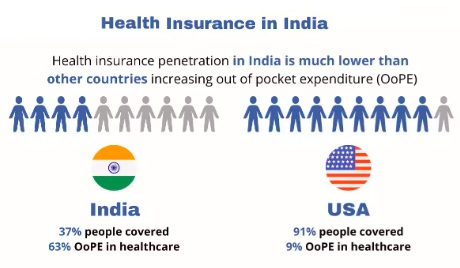
Why in News: National Health Accounts (NHA) report shows a steep decline in Out-of-Pocket Expenditure (OOPE) on health (64% in 2013-14 → 39% in 2021-22),
Introduction
- OOPE remains the dominant mode of health financing in India.
- It deepens the poverty–illness trap, forcing households into debt, asset sales, or foregone care.
Trends in OOPE (as per NHA)
- Decline claimed: 64% (2013-14) → 49% (2017-18) → 39% (2021-22).
- Credited to schemes like PMJAY, State insurance, NHM, Health & Wellness Centres.
Concerns with Estimates
- Reliance on NSS 2017-18 data, extrapolated forward.
- Misses COVID-19 impact and real distress.
- CES 2022-23, LASI, CMIE, NIA all indicate rising or steady OOPE share.
- Possible policy complacency from optimistic numbers.
Implications
1. Families fall into catastrophic health expenditure → poverty perpetuation.
2. Gendered impacts – women work longer hours, nutrition & education of children compromised.
3. Rising OOPE undermines trust in public health system.
4. Exposes gaps in financial protection schemes like PMJAY (limited coverage & hospital bias).
5. Inaccurate estimates → misaligned policy design & budget allocations.
6. Risk of urban-rural and class inequality widening in access to care.
Way Forward
1. Triangulate data – combine NSS, CES, NFHS, LASI, CMIE for realistic OOPE estimates.
2. Strengthen National Health Accounts methodology with real-time, multi-source data.
3. Increase public health spending to 2.5% of GDP (NHP 2017 target).
4. Expand primary health infrastructure and reduce dependence on private care.
5. Regulate drug prices, diagnostic costs, and private hospital charges.
6. Improve insurance design – cover outpatient & medicine costs (major OOPE drivers).
7. Invest in digital health records & transparent audits for expenditure monitoring.
Conclusion
India must ensure real financial risk protection through robust data, better public investment, and stronger regulation to move toward Universal Health Coverage.
UPSC Relevance
GS Paper II: Issues relating to health sector reforms, government schemes (PMJAY, NHM), social justice & welfare.
GS Paper III: Health expenditure trends, budgeting, data reliability, impact on poverty & inequality, Universal Health Coverage.
Mains Practice Question
Q. “Out-of-Pocket Expenditure remains a major barrier to Universal Health Coverage in India.” Critically examine with reference to recent National Health Accounts data. (15 marks, 250 words)
